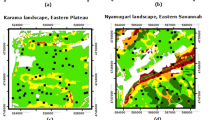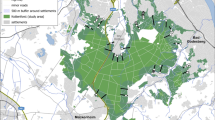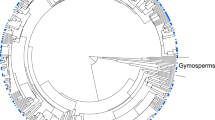Abstract
Since coexisting invasive and native plant species are exposed to similar environmental circumstances and selection pressures, variation in the morpho-functional, resource allocation and reproductive performance of these species could reflect the strategies adopted by the former for their invasion success. This study observed general differences in the morphological and physiological traits between invasive Ageratina adenophora and its co-occurring other invasive (Bidens pilosa) and native (Galinsoga ciliata) aster species in roadside populations of Kumaun Himalayan region. Plant samples were collected during their peak growth period. For the collection of plant and soil samples, five plots of 50 m × 2 m size were established at regular interval on the Nainital–Kathgodam road between 1800 and 1900 m asl. Five quadrats of 1 m × 1 m size were randomly placed at each of these plots, and from these quadrat, five individuals of each species were randomly collected. Soil was collected from 0 to 15 cm depth from all the five study plots. The results showed that soil properties did not vary among study plots and were of same nature. A. adenophora showed higher plant height and total biomass than its neighboring species and allocated more biomass to stem (76%) than G. ciliata (44%) and B. pilosa (38%) which reflects the competitive superiority of this plant over nearby vegetation for light harvesting. In contrast, highest biomass to leaves was allocated by G. ciliata (27%) followed by B. pilosa (26%) and A. adenophora (6%). The root/shoot ratio was lowest in A. adenophora and highest in B. pilosa. Specific leaf area was reported least for A. adenophora, while specific leaf weight was maximum reflecting the strategy of A. adenophora to survive in water stress conditions. High leaf dry matter content represented the physical strength and conservative strategy of A. adenophora in addition to protection from natural and biological hazards, whereas the highest seed number and reproductive index represented the superior reproductive efficiency than its co-occurring two species. Plant functional traits were positively or negatively correlated with each other and did not always exhibit higher values for A. adenophora. These findings suggest that A. adenophora possess superior traits associated with resource acquisition and resource conservation strategies in addition to advanced reproductive performance, which strongly influence the invasive success of this plant in comparison with other co-occurring native and invasive species.




Similar content being viewed by others
Data availability
Not applicable.
References
Annapurna C, Singh JS (2003) Phenotypic plasticity and plant invasiveness: case study of congress grass. Curr Sci 85:197–201
Arevalo JR, Delgado JD, Otto R et al (2005) Distribution of alien vs. native plant species in roadside communities along an altitudinal gradient in Tenerife and Gran Canaria (Canary Islands). Perspect Plant Ecol Evol Syst 7:185–202. https://doi.org/10.1016/j.ppees.2005.09.003
Asaduzzaman M, Wu H, Koetz E et al (2022) Phenology and population differentiation in reproductive plasticity in feathertop rhodes grass (Chloris virgata Sw.). Agronomy 12:736. https://doi.org/10.3390/agronomy12030736
Blonder B, Kapas RE, Dalton RM et al (2018) Microenvironment and functional-trait context dependence predict alpine plant community dynamics. J Ecol 106:1323–1337. https://doi.org/10.1111/1365-2745.12973
Brainard DC (2002) Weed management implications of a broccoli-winter rye intercropping system. Ph.D. dissertation. Cornell University, Ithaca, NY. p 136
Buschmann H, Edwards PJ, Dietz H (2005) Variation in growth pattern and response to slug damage among native and invasive provenances of four perennial Brassicaceae species. J Ecol 93:322–334. https://doi.org/10.1111/j.1365-2745.2005.00991.x
Carboni M, Calderon-Sanou I, Pollock L et al (2018) Functional traits modulate the response of alien plants along abiotic and biotic gradients. Glob Ecol Biogeogr 27:1173–1185. https://doi.org/10.1111/geb.12775
Clavel J, Lembrechts J, Alexander J et al (2021) The role of arbuscular mycorrhizal fungi in nonnative plant invasion along mountain roads. New Phytol 230:1156–1168. https://doi.org/10.1111/nph.16954
Cleland EE (2011) Trait divergence and the ecosystem impacts of invading species. New Phytol 189:649–652
Cornelissen JHC, Lavorel S, Garnier E et al (2003) A handbook of protocols for standardized and easy measurement of plant functional traits worldwide. Aust J Bot 51:335–380. https://doi.org/10.1071/BT02124
Cui Q, He WM (2009) Soil biota, but not soil nutrients, facilitate the invasion of Bidens pilosa relative to a native species Saussurea deltoidea. Weed Res 49:201–206. https://doi.org/10.1111/j.1365-3180.2008.00679.x
Divisek J, Chytry M, Beckage B et al (2018) Similarity of introduced plant species to native ones facilitates naturalization, but differences enhance invasion success. Nat Commun 9:1. https://doi.org/10.1038/s41467-018-06995-4
Drenovsky RE, Khasanova A, James J (2012) Trait convergence and plasticity among native and invasive species in resource-poor environments. Am J Bot 4:629–639. https://doi.org/10.3732/ajb.1100417
Feng Y, Wang J, Sang W (2007) Biomass allocation, morphology and photosynthesis of invasive and noninvasive exotic species grown at four irradiance levels. Acta Oecol 31:40–47. https://doi.org/10.1016/j.actao.2006.03.009
Funk JL (2008) Differences in plasticity between invasive and native plants from a low resource environment. J Ecol 96:1162–1173. https://doi.org/10.1111/j.1365-2745.2008.01435.x
Funk JL, Standish RJ, Stock WD, Valladares F (2016) Plant functional traits of dominant native and invasive species in mediterranean-climate ecosystems. Ecology 97:75–83. https://doi.org/10.1890/15-0974.1
Gallagher RV, Randall RP, Leishman M (2015) Trait differences between naturalized and invasive plant species independent of residence time and phylogeny. Conserv Biol 29:360–369. https://doi.org/10.1111/cobi.12399
Gao X, Zhao Y, Yang X, Sun S (2013) Linking trait differences to community dynamics: evidence from Eupatorium adenophorum and co-occurring native species during a three-year succession. PLoS ONE 8:e50247. https://doi.org/10.1371/journal.pone.0050247
Gioria M, Pysek P (2017) Early bird catches the worm: germination as a critical step in plant invasion. Biol Invasions 19:1055–1080. https://doi.org/10.1007/s10530-016-1349-1
Gorne LD, Diaz S, Minden V (2022) The acquisitive–conservative axis of leaf trait variation emerges even in homogeneous environments. Ann Bot 129:709–722. https://doi.org/10.1093/aob/mcaa198
Gross N, Suding KN, Lavorel S et al (2007) Complementarity as a mechanism of coexistence between functional groups of grasses. J Ecol 95:1296–1305. https://doi.org/10.1111/j.1365-2745.2007.01303.x
Gross N, Borger L, Duncan RP et al (2013) Functional differences between alien and native species: do biotic interactions determine the functional structure of highly invaded grasslands? Funct Ecol 27:1262–1272. https://doi.org/10.1111/1365-2435.12120
Gusewell S, Jakobs G, Weber E (2006) Native and introduced populations of Solidago gigantea differ in shoot production but not in leaf traits or litter decomposition. Funct Ecol 20:575–584
Hulme PE, Bernard-Verdier M (2018) Comparing traits of native and alien plants: Can we do better? Funct Ecol 32:117–125. https://doi.org/10.1111/1365-2435.12982
Hwang BC, Lauenroth WK (2008) Effect of nitrogen, water and neighbor density on the growth of Hesperis matronalis and two native perennials. Biol Invasions 10:771–779. https://doi.org/10.1007/s10530-007-9171-4
Jhariya MK, Banerjee A, Raj A et al (2022) Species invasion and ecological risk. Natural resources conservation and advances for sustainability. Elsevier, Amsterdam, pp 503–531. https://doi.org/10.1016/B978-0-12-822976-7.00014-4
Khatri K, Bargali K, Bargali SS et al (2022a) Effects of leaf residues from Ageratina adenophora on germination, growth and productivity of two rabi crops. Acta Ecol Sin. https://doi.org/10.1016/j.chnaes.2022.05.001
Khatri K, Negi B, Bargali K et al (2022b) Spatial variation in allelopathic inhibition by Ageratina adenophora on growth and yield of two traditional millet crops. Vegetos. https://doi.org/10.1007/s42535-022-00353-y
Khatri K, Negi B, Bargali K et al (2022c) Effects of elevation and habitat on leaf and reproductive traits of Ageratina adenophora (Sprengel) King & Robinson. S Afr J Bot 147:859–870. https://doi.org/10.1007/s42535-022-00353-y
Khatri K, Bargali K, Negi B et al (2020) Germination and early seedling growth of two rice varieties as affected by invasive Ageratina adenophora. Curr Agric Res J 8:108–117. https://doi.org/10.12944/CARJ.8.2.06
Kumar V, Brainard DC, Bellinder RR (2009) Effects of spring-sown cover crops on establishment and growth of hairy galinsoga (Galinsoga ciliata) and four vegetable crops. Hortic Sci 44:730–736. https://doi.org/10.21273/HORTSCI.44.3.730
Kumar M, Garkoti SC (2021) Functional traits, growth patterns, and litter dynamics of invasive alien and co-occurring native shrub species of chir pine forest in the central Himalaya, India. Plant Ecol 222:723–735. https://doi.org/10.1007/s11258-021-01140-6
Lambert E, Dutartre A, Coudreuse J, Haury J (2010) Relationships between the biomass production of invasive Ludwigia species and physical properties of habitats in France. Hydrobiologia 656:173–186. https://doi.org/10.1007/s10750-010-0440-3
Leffler AJ, James JJ, Monaco TA, Sheley RL (2014) A new perspective on trait differences between native and invasive exotic plants. Ecology 95:298–305. https://doi.org/10.1890/13-0102.1
Liao H, Pal RW, Niinemets U et al (2021) Different functional characteristics can explain different dimensions of plant invasion success. J Ecol 109:1524–1536. https://doi.org/10.1111/1365-2745.13575
Liu Y, Li Z, Xu L et al (2022) Effects of region and elevation on adaptation of leaf functional traits of an invasive plant Erigeron annuus in China. Phyton 91:115–118. https://doi.org/10.32604/phyton.2022.015395
Mahmoud T, Gairola S, El-Keblawy A (2015) Parthenium hysterophorus and Bidens pilosa, two new records to the invasive weed flora of the United Arab Emirates. J New Biol Rep 4:26–32
Mathakutha R, Steyn C, le Roux PC et al (2019) Invasive species differ in key functional traits from native and non-invasive alien plant species. J Veg Sci 30:994–1006. https://doi.org/10.1111/jvs.12772
Matzek V (2011) Superior performance and nutrient-use efficiency of invasive plants over non-invasive congeners in a resource-limited environment. Biol Invasions 13:3005–3014. https://doi.org/10.1007/s10530-011-9985-y
McConnaughay KDM, Coleman JS (1999) Biomass allocation in plants: Ontogeny or optimality? a test along three resource gradients. Ecology 80:2581–2593. https://doi.org/10.1890/0012-9658(1999)080[2581:BAIPOO]2.0.CO;2
McGrannachan CM, McGeoch MA (2019) Multispecies plant invasion increases function but reduces variability across an understorey metacommunity. Biol Invasions 21:1115–1129. https://doi.org/10.1007/s10530-018-1883-0
Meng FQ, Cao R, Yang DM et al (2014) Trade-offs between light interception and leaf water shedding: a comparison of shade- and sun-adapted species in a subtropical rainforest. Oecologia 174:13–22. https://doi.org/10.1007/s00442-013-2746-0
Mitchell RM, Ames GM, Wright JP (2021) Intraspecific trait variability shapes leaf trait response to altered fire regimes. Ann Bot 127:543–552. https://doi.org/10.1093/aob/mcaa179
Moretti M, de Bello F, Ibanez S et al (2013) Linking traits between plants and invertebrate herbivores to track functional effects of land-use changes. J Veg Sci 24:949–962. https://doi.org/10.1111/jvs.12022
Ni G, Zhao P, Ye Y et al (2020) High photosynthetic capacity and energy-use efficiency benefit both growth and chemical defense in invasive plants. Chemoecology 30:69–78. https://doi.org/10.1007/s00049-020-00299-0
Oh M, Heo Y, Lee EJ, Lee H (2021) Major environmental factors and traits of invasive alien plants determining their spatial distribution. J Ecol Environ 45:1. https://doi.org/10.1186/s41610-021-00208-8
Ordonez A (2014) Functional and phylogenetic similarity of alien plants to co-occurring natives. Ecology 95:1191–1202. https://doi.org/10.1890/13-1002.1
Ordonez A, Wright IJ, Olff H (2010) Functional differences between native and alien species: a global-scale comparison. Funct Ecol 24:1353–1361. https://doi.org/10.1111/j.1365-2435.2010.01739.x
Pathak R, Negi VS, Rawal RS, Bhatt ID (2019) Alien plant invasion in the Indian Himalayan region: state of knowledge and research priorities. Biodivers Conserv 28:3073–3102. https://doi.org/10.1007/s10531-019-01829-1
Pauchard A, Milbau A, Albihn A et al (2016) Non-native and native organisms moving into high elevation and high latitude ecosystems in an era of climate change: new challenges for ecology and conservation. Biol Invasions 18:345–353. https://doi.org/10.1007/s10530-015-1025-x
Pearson DE, Ortega YK, Eren O, Hierro JL (2018) Community assembly theory as a framework for biological invasions. Trends Ecol Evol 33:313–325. https://doi.org/10.1016/j.tree.2018.03.002
Pierce S, Negreiros D, Cerabolini BEL et al (2017) A global method for calculating plant CSR ecological strategies applied across biomes world-wide. Funct Ecol 31:444–457. https://doi.org/10.1111/1365-2435.12722
Poorter L (1999) Growth responses of 15 rain forest tree species to a light gradient: the relative importance of morphological and physiological traits. Funct Ecol 13:396–410
Poudel AS, Jha PK, Shrestha BB, Muniappan R (2019) Biology and management of the invasive weed Ageratina adenophora (Asteraceae): current state of knowledge and future research needs. Weed Res 59:79–92. https://doi.org/10.1111/wre.12351
Powell KI, Chase JM, Knight TM (2013) Invasive plants have scale-dependent effects on diversity by altering species-area relationships. Science 339:316–318. https://doi.org/10.1126/science.1226817
Puglielli G, Laanisto L, Poorter H, Niinemets U (2021) Global patterns of biomass allocation in woody species with different tolerances of shade and drought: evidence for multiple strategies. New Phytol 229:308–322. https://doi.org/10.1111/nph.16879
Ricciardi A, Blackburn TM, Carlton JT et al (2017) Invasion science: A horizon scan of emerging challenges and opportunities. Trends Ecol Evol 32:464–474. https://doi.org/10.1016/j.tree.2017.03.007
Ruwanza S, Mhlongo ES (2020) Lantana camara invasion along road-river interchanges and roadsides in Soutpansberg, vhembe biosphere reserve in South Africa. S Afr J Sci 116:1–5. https://doi.org/10.17159/sajs.2020/8302
Sekar KC, Manikandan R, Srivastava SK (2012) Invasive alien plants of uttarakhand himalaya. Proc Natl Acad Sci India Sect B Biol Sci 82:375–383. https://doi.org/10.1007/s40011-012-0040-2
Sharma GP, Esler KJ (2008) Phenotypic plasticity among Echium plantagineum populations in different habitats of Western Cape, South Africa. S Afr J Bot 74:746–749. https://doi.org/10.1016/j.sajb.2008.04.006
Soudzilovskaia NA, Elumeeva TG, Onipchenko VG et al (2013) Functional traits predict relationship between plant abundance dynamic and long-term climate warming. Proc Natl Acad Sci USA 110:18180–18184. https://doi.org/10.1073/pnas.1310700110
Tang L, Zhou QS, Gao Y, Li P (2022) Biomass allocation in response to salinity and competition in native and invasive species. Ecosphere 13:e3900. https://doi.org/10.1002/ecs2.3900
Thomson FJ, Moles AT, Auld TD et al (2011) Seed dispersal distance is more strongly correlated with plant height than with seed mass. J Ecol 99:1299–1307. https://doi.org/10.1111/j.1365-2745.2011.01867.x
Toledo-Aceves T, García-Hernández MD, Paz H (2019) Leaf functional traits predict cloud forest tree seedling survival along an elevation gradient. Ann for Sci 76:1–6. https://doi.org/10.17871/TRY.50
Vico G, Manzoni S, Nkurunziza L et al (2016) Trade-offs between seed output and life span–a quantitative comparison of traits between annual and perennial congeneric species. New Phytol 209:104–114. https://doi.org/10.1111/nph.13574
Wang R, Qiang J (2017) Photosynthetic carbon gain, allocation and resources-use efficiency in invasive Eupatorium adenophorum and its native congener E. Japonicum under different light and nutrient conditions. Agric Sci Technol 18:1832–1840
Wang Z, Zhang L (2012) Leaf shape alters the coefficients of leaf area estimation models for Saussurea stoliczkai in central Tibet. Photosynthetica 50:337–342. https://doi.org/10.1007/s11099-012-0039-1
Wang R, Kang X, Quan G et al (2016) Influence of Lantana camara on soil II. Effects of Lantana camara leaf litter on plants and soil properties. Allelopathy J 35:207–216
Wang CY, Zhou JW, Jiang K et al (2017a) Differences in leaf functional traits and allelopathic effects on seed germination and growth of Lactuca sativa between red and green leaves of Rhus typhina. S Afr J Bot 111:17–22. https://doi.org/10.1016/j.sajb.2017.03.019
Wang CY, Zhou JW, Xiao HG et al (2017b) Variations in leaf functional traits among plant species grouped by growth and leaf types in Zhenjiang, China. J for Res 28:241–248. https://doi.org/10.1007/s11676-016-0290-6
Wang C, Zhou J, Liu J et al (2018) Differences in functional traits and reproductive allocations between native and invasive plants. S Afr J Bot 25:516–525. https://doi.org/10.1007/s11771-018-3756-1
Weber E, Schmid B (1998) Latitudinal population differentiation in two species of Solidago (Asteraceae) introduced into Europe. Am J Bot 85:1110–1121. https://doi.org/10.2307/2446344
Wilsey BJ, Polley HW (2006) Aboveground productivity and root-shoot allocation differ between native and introduced grass species. Oecologia 150:300–309. https://doi.org/10.1007/s00442-006-0515-z
Yadav AS, Tripathi RS (1985) Effect of soil-moisture and sowing density on population-growth of Eupatorium adenophorum and Eupatorium riparium. Plant Soil 88:441–447. https://doi.org/10.1007/BF02197501
Yang M, Lu Z, Fan Z et al (2018) Distribution of non-native plant species along elevation gradients in a protected area in the eastern Himalayas. China Alp Bot 128:169–178. https://doi.org/10.1007/s00035-018-0205-6
Zhang Y, Wu H, Horandl E et al (2021) Autonomous apomixis in Praxelis clematidea (Asteraceae: Eupatorieae), an invasive alien plant. AoB Plants 13:plab007. https://doi.org/10.1093/aobpla/plab007
Zhao Y, Yang X, Xi X et al (2012) Phenotypic plasticity in the invasion of crofton weed (Eupatorium adenophorum) in China. Weed Sci 60:431–439. https://doi.org/10.1614/WS-D-11-00198.1
Zou JW, Rogers WE, DeWalt SJ et al (2006) The effect of Chinese tallow tree (Sapium sebiferum) ecotype on soil-plant system carbon and nitrogen processes. Oecologia 150:272–281. https://doi.org/10.1007/s00442-006-0512-2
Acknowledgements
The authors are grateful to the Head, Department of Botany, D.S.B. Campus, Kumaun University, Nainital, Uttarakhand, for providing all sorts of facilities. We also thank Department of Science and Technology (DST)-New Delhi, (DST-SERB/CRG/2019/004139), Government of India, for the financial assistance. The authors are highly thankful for the constructive comments of the Editor, Associate Editor and the Reviewers which improved our manuscript.
Funding
This research was funded by Department of Science & Technology (DST)—Science & Engineering Research Board (SERB), New Delhi (File No.: DST-SERB/CRG/2019/004139), Government of India.
Author information
Authors and Affiliations
Contributions
KK: collected and analyzed the data and prepared the first draft. BN: helped in data collection. KB and SSB: have designed and guided the research, reviewed and modified the manuscript.
Corresponding author
Ethics declarations
Conflict of interest
The authors declare that they have no conflict of interest.
Additional information
Publisher's Note
Springer Nature remains neutral with regard to jurisdictional claims in published maps and institutional affiliations.
Supplementary Information
Below is the link to the electronic supplementary material.
Rights and permissions
Springer Nature or its licensor holds exclusive rights to this article under a publishing agreement with the author(s) or other rightsholder(s); author self-archiving of the accepted manuscript version of this article is solely governed by the terms of such publishing agreement and applicable law.
About this article
Cite this article
Khatri, K., Negi, B., Bargali, K. et al. Trait variability in co-occurring invasive and native plant species in road side population of Kumaun Himalaya. Braz. J. Bot 45, 1099–1110 (2022). https://doi.org/10.1007/s40415-022-00827-y
Received:
Revised:
Accepted:
Published:
Issue Date:
DOI: https://doi.org/10.1007/s40415-022-00827-y




